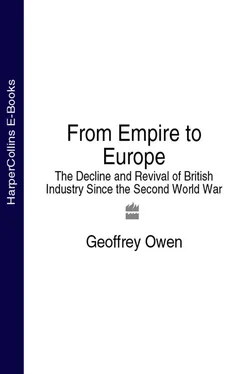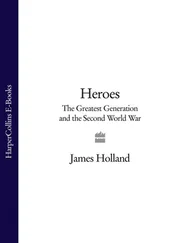Given the difficult international environment, British industrial performance in the inter-war years was creditable, at least in comparison with other European countries. 49As TABLE 2.2 shows, Germany and Britain were roughly on a par in terms of manufacturing productivity at the end of the 1930s, as they had been just before the First World War, and not far apart in their share of world manufacturing production (TABLE 2.3). The failure, if there was one, was in relation to the US, where productivity was more than double the European level. The American lead was based on a large, tariff-free home market, an abundance of raw materials, and institutions and policies which encouraged entrepreneurship and innovation.
TABLE 2.3 Shares of world manufacturing output, 1913 and 1938
(per centage of total)
|
1913 |
1938 |
| US |
32.0 |
31.4 |
| Germany |
14.8 |
12.7 |
| Britain |
13.6 |
10.7 |
| Japan |
2.7 |
5.2 |
| France |
6.1 |
4.4 |
| Italy |
2.4 |
2.8 |
| Others |
28.4 |
32.8 |
Source: Paul Bairoch, ‘International Industrialisation Levels from 1750 to 1980’, Journal of European Economic History , vol. 11, no. 2, Fall 1982.
Britain’s early start in the industrial revolution had left some lasting legacies, some of which would prove troublesome after the Second World War. One was a large commitment to older industries, such as cotton textiles and shipbuilding, which had been built up during the nineteenth century. Another was a pattern of trade originating from the days when Britain exchanged the products of the first industrial revolution – textiles, coal, iron – for food and raw materials from the primary producing countries. The bias towards non-European markets was reinforced by the protectionism of the inter-war years. The newer industries, in particular, became increasingly dependent on the dominions and colonies; in 1938 three-quarters of Britain’s electrical machinery and car exports went to imperial markets. This was to a large extent the inevitable result of high tariffs in other European countries, but it encouraged the view that overseas trade should be based on complementarity rather than competition. Trade with developing countries, inside and outside the Empire, seemed more natural than trade between industrial countries which had similar industrial structures and produced similar goods.
Britain’s distinctive industrial history had left its mark on the three institutions which were referred to in the first chapter – the financial system, the education system and the labour relations system. But in all three fields a process of evolution had taken place before and after the First World War, and none of them can be seen as a fatal disability which condemned British industry to decline after 1945. The labour relations system, for example, had stabilised after the drama of the 1926 General Strike. If attitudes on the part of unions and employers were adversarial, there was a pragmatic recognition that a modus vivendi had to be worked out, and that orderly procedures for dealing with disputes were in everyone’s interests. It can hardly be said that this was a worse preparation for the post-war period than the bitterness which characterised German labour relations during the 1920s and early 1930s, leading to the extinction of the trade union movement under the Nazis.
A damaging consequence of the inter-war depression was the retreat from liberalism in British economic and industrial policy. The abandonment of free trade in 1932 was accompanied by the spread of price-fixing and market-sharing arrangements, condoned and even encouraged by the government in the hope that they would encourage rationalisation. The lack of internal competition, together with protection against imports, created an environment which was not conducive to industrial efficiency. But these policies were not confined to Britain; the cartel habit was even more deeply entrenched in Germany.
Britain was not the only country with awkward legacies from the past, and British industry was not obviously less well equipped than its European competitors to benefit from the more favourable international environment that prevailed after the Second World War. Explanations for what went wrong after 1945 have to be found in the post-war period itself.
Конец ознакомительного фрагмента.
Текст предоставлен ООО «ЛитРес».
Прочитайте эту книгу целиком, купив полную легальную версию на ЛитРес.
Безопасно оплатить книгу можно банковской картой Visa, MasterCard, Maestro, со счета мобильного телефона, с платежного терминала, в салоне МТС или Связной, через PayPal, WebMoney, Яндекс.Деньги, QIWI Кошелек, бонусными картами или другим удобным Вам способом.












